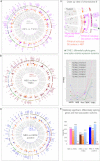RNA sequencing of cancer reveals novel splicing alterations
- PMID: 23604310
- PMCID: PMC3631769
- DOI: 10.1038/srep01689
RNA sequencing of cancer reveals novel splicing alterations
Abstract
Breast cancer transcriptome acquires a myriad of regulation changes, and splicing is critical for the cell to "tailor-make" specific functional transcripts. We systematically revealed splicing signatures of the three most common types of breast tumors using RNA sequencing: TNBC, non-TNBC and HER2-positive breast cancer. We discovered subtype specific differentially spliced genes and splice isoforms not previously recognized in human transcriptome. Further, we showed that exon skip and intron retention are predominant splice events in breast cancer. In addition, we found that differential expression of primary transcripts and promoter switching are significantly deregulated in breast cancer compared to normal breast. We validated the presence of novel hybrid isoforms of critical molecules like CDK4, LARP1, ADD3, and PHLPP2. Our study provides the first comprehensive portrait of transcriptional and splicing signatures specific to breast cancer sub-types, as well as previously unknown transcripts that prompt the need for complete annotation of tissue and disease specific transcriptome.
Figures







References
Publication types
MeSH terms
Substances
LinkOut - more resources
Full Text Sources
Other Literature Sources
Medical
Molecular Biology Databases
Research Materials
Miscellaneous

